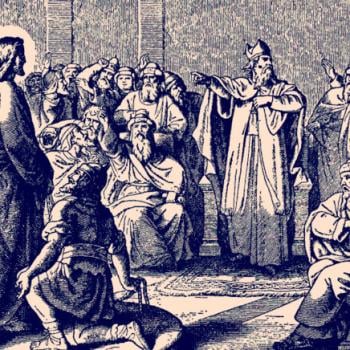Luke 11:1-4 Essentials of An Effective Prayer Life
Luke 11:1-4 Essentials of An Effective Prayer Life is a sermon from the Lord’s Prayer.
When a brain tumor took away Dorothy Holm’s ability to speak, she picked up index cards and began filling them with what appeared to be random sequences of letters. When Dorothy passed away in 1996, her 11-year-old granddaughter Janna kept the cards, thinking they might be some kind of coded message. As a teenager, she thought the letters might be song lyrics or a secret message to the grandchildren, but eventually she gave up when she could not figure out the meaning.
In January 2014, she posted a picture of one of the cards to the Internet site Metafilter.com and had an answer within 15 minutes. Someone using the site recognized the letters OFWAIHHBTN as the first letters of the words in the beginning of the Lord’s Prayer: “Our Father, who art in heaven, hallowed be Thy name.” Holm said she was relieved to have an answer, even if she will never know what some of the other letters on her grandmother’s index cards stand for. She said, “It’s nice to know that they were prayers, and kind of gave some insight into what she was thinking and what she focused on in her last couple weeks. I don’t care if a little bit of it never gets solved. It’s OK to have a little bit of mystery.”1
In this passage, Jesus shows us the essentials to an effective prayer life. Jesus was a man of prayer. He prayed early in the morning and He prayed often. His disciples were watching Him pray and decided to ask Him how to pray.
“He was praying in a certain place, and when He finished, one of His disciples said to Him, “Lord, teach us to pray, just as John also taught his disciples.”” (Luke 11:1, HCSB)
Jesus often went away to pray (cf. Lk 6:12; 22:39ff). This practice of the Master’s causes his disciples to want to learn how to pray. Jesus teaches them to do what he himself does.2
The disciples, who spent day and night with Jesus didn’t know how to pray. If that was true of the disciples, then it is also true of us. Many of us may not know how to pray. We need to learn to pray. It is a skill that needs to be taught. So the first question to ask is:
What is prayer?
Effective prayer is the provision for every need and the solution for every problem.3
In these verses, we see first the importance of prayer (11:1–2). We are also shown the substance of prayer (11:2–4). The ‘Lord’s prayer’, even in this briefer version (the fuller one is in Matthew 6:9–13), is a model, not in the sense that these are the actual words with which we should pray, but in the sense that these are the lines along which we should pray.4
Prayer is communication with God. Prayer is talking to God. But what should you talk to God about? Well, we should start with the basics. That is what Jesus taught His disciples. It is what He teaches us. There are five basic elements to a Christian’s prayer life.
In each of these cases, the proper prayer is addressed to God and the people who prays focuses on God, not themselves. For an effective prayer life, I need to communicate to God about God asking God for God’s help in God’s way. Prayer centers myself on God. It does not center God on me.
Notice that the disciples didn’t say, “Teach us how to pray,” but rather, simply, “Teach us to pray.” Every one of us who is a believer knows that the posture of prayer is the place of power. So why don’t we pray? I believe one reason is that we have greatly complicated prayer. We have made it something it was never intended to be because we have believed the lie of the Enemy that prayer is difficult, time-consuming, heavy.5
You may remember this prayer differently. The so-called Lord’s Prayer actually comes from Matthew 6. Luke 11 shares a shortened version.
In the quest for an earliest possible wording the frequently advocated thesis might well prove to be the best explanation—that on the whole Luke is earlier in the number of petitions and in the address, while Matthew’s wording is earlier. However, the reference to spontaneous variations of Jewish prayers is more helpful.6 They explain Matthew’s additional petitions as well as possible changes of the wording.7
We call this “The Lord’s Prayer,” not because Jesus prayed it (He never had to ask for forgiveness), but because Jesus taught it.8
I want to share with you five essentials to an effective prayer life.
FIVE ESSENTIALS TO AN EFFECTIVE PRAYER LIFE9
1. God’s name (Luke 11:2)
…“Whenever you pray, say: Father, Your name be honored as holy…” (Luke 11:2, HCSB)
Image: Thumb’s Up
God’s name is personal. Jesus addressed Him as Father, or Daddy. This shows that when we pray, we pray to a personal God. At the same time, we pray to a God with respect. Just as a child learns to respect the father, Jesus showed respect to His father. He respected Him and His name.
When you pray, you want to give God a thumb’s up.
2. God’s kingdom (Luke 11:2)
“…Your kingdom come….” (Luke 11:2, HCSB)
Image: Point index finger upwards
In this case, this prayer reminds us to point our finger upwards. We pray for God’s kingdom to be #1. Jesus prayed for God’s will because He was interested in God’s kingdom. He put God’s desires above His own.
3. God’s provision (Luke 11:3)
“Give us each day our daily bread.” (Luke 11:3, HCSB)
Image: Disney point of two fingers
Next, we use the “Disney point” to show us that God provides for us. When I worked for Walt Disney World, they taught us to point people in the right direction with two fingers, like this. The reason is because in a park as big as this, you might point at someone and that is considered rude. As a cast member, we pointed people in the right direction.
This image reminds us that God’s provision points us in the right direction. Each day we depend on God. For most of us, we live on more than just our daily bread. But in Jesus’ time, and even now for some people, they live day-to-day. So we need help everyday. We need to pray that God will provide for us the right direction in life. Whether that is food, work, relationships, or other decision, we need to ask God to help us. He shows us what we need, and He points us in the right direction.
4. God’s forgiveness (Luke 11:4)
“And forgive us our sins, for we ourselves also forgive everyone in debt to us…”” (Luke 11:4, HCSB)
Image: Ring finger
Next, we use the ring finger. The ring on the ring finger reminds me that I made a promise to my wife. I will be faithful to her until death. When it comes to prayer, God has promised to be faithful in giving forgiveness.
5. God’s deliverance (Luke 11:4)
“…And do not bring us into temptation.”” (Luke 11:4, HCSB)
Image: Pinky promise
Lastly, we use the pinky finger. How do you use the pinky finger as a reminder in prayer? The pinky finger is used in a pinky promise. What is a pinky promise? A promise is promise between friends. When one gets into trouble, the other friend will help them out. As Christians, we can easily get into trouble. Satan is out there trying to tempt us to sin and commit evil. But when we pray for God’s deliverance from evil, it is a like a pinky promise. I hook my pinky to God’s pinky (which would be a very large pinky) and He promises to help me out.
Jesus is saying here that we should ask the Father not to direct us, as he did our Master, into that place of testing, not to leave us exposed to the unbridled attacks of the enemy, for we are not confident that we have the strength to withstand that kind of assault on our souls.10 In His answer to His disciples’ request, we first see Jesus give a pattern for prayer. Teaching them a prayer only sixty-two words long, it was as if Jesus was saying, “Keep it simple.”11
That’s the way to learn prayer. Keep it simple. God loves a simple, but effective prayer life.
1 Jim L. Wilson and Jim Sandell, “Unable to Speak, but Praying in Code,” in 300 Illustrations for Preachers, ed. Elliot Ritzema (Bellingham, WA: Lexham Press, 2015).
2 Saint Luke’s Gospel, The Navarre Bible (Dublin; New York: Four Courts Press; Scepter Publishers, 2005), 113.
3 Warren W. Wiersbe, The Bible Exposition Commentary, vol. 1 (Wheaton, IL: Victor Books, 1996), 214.
4 Michael Wilcock, The Savior of the World: The Message of Luke’s Gospel, The Bible Speaks Today (Downers Grove, IL: InterVarsity Press, 1979), 125–126.
5 Jon Courson, Jon Courson’s Application Commentary (Nashville, TN: Thomas Nelson, 2003), 356.
617 Heinemann, Prayer, 43; cf. 46, 63. Israel Abrahams (“Some Rabbinic Ideas of Prayer,” in Studies 2.84, n. 2) calls attention to rabbinic texts that simply forbid fixing prayers literally: m. ʾAbot 2.13; m. Ber. 4.4; b. Ber. 29b. Y. Ber. 4.4.8a (German trans. by Charles Horowitz [Tübingen: Mohr/Siebeck, 1975] 127): “Only (one may) not (perform the prayer) as if one were reading a letter.… Every day one is to add something new (to the prescribed prayer).”
7 Ulrich Luz, Matthew 1–7: A Commentary on Matthew 1–7, ed. Helmut Koester, Rev. ed., Hermeneia—a Critical and Historical Commentary on the Bible (Minneapolis, MN: Fortress Press, 2007), 310.
8 Warren W. Wiersbe, The Bible Exposition Commentary, vol. 1 (Wheaton, IL: Victor Books, 1996), 214.
9 Jim Erwin, “Five Essentials of An Effective Prayer Life”, Simple Thoughts Reflections 2016 (Logos Bible Software Notes), 8 January 2016, http://www.patheos.com/blogs/jimerwin/2016/01/08/five-essentials-of-an-effective-prayer-life/.
10 R. C. Sproul, A Walk with God: An Exposition of Luke (Great Britain: Christian Focus Publications, 1999), 238.
11 Jon Courson, Jon Courson’s Application Commentary (Nashville, TN: Thomas Nelson, 2003), 356.
















